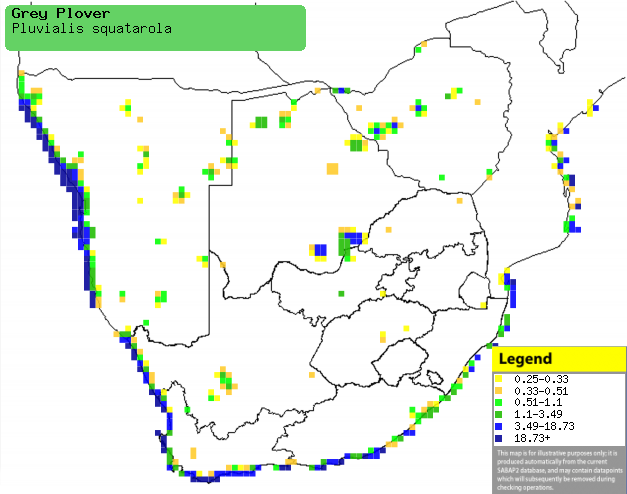|
Pluvialis squatarola (Grey
plover)
Grysstrandkiewiet [Afrikaans]; Zilverplevier [Dutch];
Pluvier argenté [French]; Kiebitzregenpfeifer [German];
Tarambola-cinzenta [Portuguese]
Life
> Eukaryotes >
Opisthokonta
> Metazoa (animals) >
Bilateria >
Deuterostomia > Chordata >
Craniata > Vertebrata (vertebrates) > Gnathostomata (jawed
vertebrates) > Teleostomi (teleost fish) > Osteichthyes (bony fish) > Class:
Sarcopterygii (lobe-finned
fish) > Stegocephalia (terrestrial
vertebrates) > Tetrapoda
(four-legged vertebrates) > Reptiliomorpha > Amniota >
Reptilia (reptiles) >
Romeriida > Diapsida > Archosauromorpha > Archosauria >
Dinosauria
(dinosaurs) > Saurischia > Theropoda (bipedal predatory dinosaurs) >
Coelurosauria > Maniraptora > Aves
(birds) >
Order: Charadriiformes > Family: Charadriidae
> Genus: Pluvialis
Distribution and habitat
Breeds in Arctic tundra from the White Sea of north-western
Europe across Asia to northern Canada, heading south in the non-breeding season
to coasts across the world between 55° North and 40° South. In southern Africa it is common along the coast, while it is a vagrant further inland,
generally preferring muddy or sandy intertidal areas of estuaries or sandy or
rocky coasts. It often roosts on salt-marshes, sandbanks, beaches or dunes.
|
 |
|
Distribution of Grey plover in southern Africa,
based on statistical smoothing of the records from first SA Bird Atlas
Project (©
Animal Demography unit, University of
Cape Town; smoothing by Birgit Erni and Francesca Little). Colours range
from dark blue (most common) through to yellow (least common).
See here for the latest distribution
from the SABAP2. |
Movements and migrations
Southern African birds are thought to originate
from the Taimyr Peninsula, Siberia, departing in August and heading
south through Ukraine, Romania and Italy before eventually arriving
in southern Africa in September. It leaves the region in the period
from February-April, mainly in April.
Food
It mainly eats intertidal invertebrates, especially
polychaete worms, typically using the typical, run-stop-search technique of plovers.
It hunts visually by day and night, although it takes longer for it
to locate small animals in the dark. The following food items have been recorded
in its diet:
- Invertebrates
- polychaete worms
- crustaceans
- crabs
- Cleistostoma
- Hymenosoma orbiculare
- Thaumastoplax spiralis
- Upogebia africana (estuarine mud prawns)
- Callianassa kraussi (sandprawns)
- amphipods
- mysid shrimps
- barnacles
- molluscs
- small clams
- Assiminea bifasciata (snails)
- insects and their larvae
- flies, including Lonchoptera
- Vertebrates
Threats
Not threatened, in fact its population is thought to be
increasing in size.
References
-
Hockey PAR, Dean WRJ and Ryan PG 2005. Roberts
- Birds of southern Africa, VIIth ed. The Trustees of the John Voelcker
Bird Book Fund, Cape Town.
|
